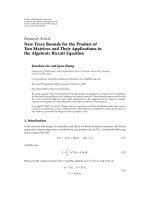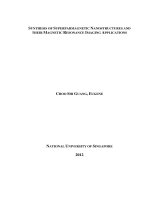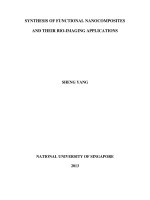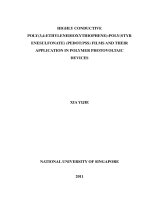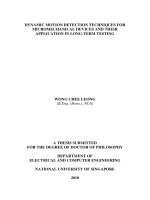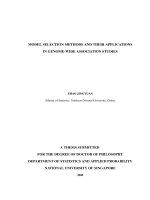The synthesis of 1,3-dialkyl-4-methylimidazolinium salts and their application in palladium catalyzed Heck coupling reactions
Bạn đang xem bản rút gọn của tài liệu. Xem và tải ngay bản đầy đủ của tài liệu tại đây (127.39 KB, 9 trang )
Turk J Chem
(2015) 39: 281 289
ă ITAK
c TUB
Turkish Journal of Chemistry
/>
doi:10.3906/kim-1408-33
Research Article
The synthesis of 1,3-dialkyl-4-methylimidazolinium salts and their application in
palladium catalyzed Heck coupling reactions
1
IT
1,, Gă
IT
1 , Ismail
ă
2
Murat YI G
ulin BAYAM1 , Beyhan YI G
OZDEM
IR
Department of Chemistry, Faculty of Science and Arts, Adıyaman University, Adıyaman, Turkey
2
onă
Department of Chemistry, Faculty of Science and Arts, Ină
u University, Malatya, Turkey
Received: 13.08.2014
•
Accepted/Published Online: 25.11.2014
•
Printed: 30.04.2015
Abstract:Seven novel 1,3-dialkyl-4-methylimidazolinium chloride salts 3a–g were prepared as precursors of N-heterocyclic
carbenes by reacting N,N’-alkyl-1,2-diaminopropane, triethyl orthoformate, and ammonium chloride. The salts were
characterized spectroscopically. The in situ prepared palladium complexes derived from the imidazolinium salts and palladium acetate were used as catalyst in Heck coupling reactions between aryl bromides and styrene. The corresponding
Heck products were obtained in good yields.
Key words: Heck reaction, imidazolinium salt, palladium, N-heterocyclic carbene, catalyst
1. Introduction
The palladium-catalyzed coupling reaction of aryl or vinyl halides with various alkenes, the Mizoroki–Heck
reaction, is an extremely valuable method for carbon–carbon bond formation. 1−4 This powerful reaction has
been widely used in the synthesis of important functionalized compounds. Traditionally, Heck reactions of
aryl halides with alkenes are carried out using various palladium phosphine catalysts. 5−11 In recent years, a
great deal of attention has been paid to the design and synthesis of palladium complexes that can be used
as an alternate to air-sensitive and toxic palladium phosphine catalysts. Thus, N-heterocyclic carbenes, Schiff
bases, amines, oxazolines, pyridines, hydroxyquinolines, hydrazones, tetrazoles, and N-phenylurea have been
used as ligands in Heck and Suzuki coupling reactions. 12−25 N-heterocyclic carbenes have received a great deal
of attention as alternatives to phosphine-based ligands in palladium-catalyzed coupling reactions. 26−28 Both
metal/NHC complexes and metal/imidazolium salts systems can be used in a number of coupling reactions. 29−36
The imidazolinium and benzimidazolium salts are an effective ligand precursor for palladium-catalyzed carbon–
carbon bond forming reactions. 37−41 These salts are readily prepared by alkylation of dihydroimidazole and by
cyclization reactions of a secondary bisamine with triethyl orthoformate in the presence of ammonium salt or
N,N’-dialkyl-1,2-diaminoethane dihydro halides with triethyl orthoformate. 42−44
The number, nature, and position of the substituents on the nitrogen atoms or NHC ring have tremendous
influence on the rate of catalyzed reactions and stability of complexes of NHCs against heat, moisture, and air.
Therefore, NHC ligands can be easily modified by changing the substituents on the nitrogen atoms or carbene
ring. Thousands of free and metal-coordinated N-heterocyclic carbenes have been reported, but NHCs bearing
different groups on the backbone of the carbenes are relatively rare. 45−56
∗ Correspondence:
281
˘ IT
˙ et al./Turk J Chem
YI˙ G
Herein we report the synthesis and characterization of new imidazolinium chloride salts bearing benzyl
substituents on nitrogen atoms and methyl-substituent on the 4-position as N-heterocyclic carbene precursors
and the use of the in situ generated catalytic system composed of Pd(OAc) 2 and these salts for Heck crosscoupling of aryl bromides with styrene.
2. Results and discussion
2.1. Synthesis and characterization of imidazolinium salts, 3a–g
As shown in the Scheme, the synthesis of the symmetrical 1,3-dialkyl-4-methylimidazolinium salts 3 was
achieved in three steps. The condensation reaction of 1,2-diaminopropane with two molar equivalents of the
aromatic aldehydes in ethanol gave the corresponding Schiff bases 1, which were subsequently treated with
sodium borohydride in methanol at room temperature to produce the corresponding benzylic diamines 2. The
cyclization of N,N’-dialkylpropane-1,2-diamines leading to the symmetrical 1,3-dialkyl-4-methylimidazolinium
salts 3 was carried out with triethyl ortoformate and ammonium chloride. After purification, pure products
were obtained as colorless solids in good yields (76%–89%). The salts are soluble in the common polar solvents
and are air- and moisture-stable both in the solid state and in solution. The structures of the 1,3-dialkyl-4methylimidazolinium salts have been fully identified by 1 H and 13 C NMR spectroscopy, FTIR, and elemental
analysis. All results were in agreement with the proposed structure. They show a characteristic υ(N CN ) band
at 1556–1638 cm −1 . NMR spectroscopic data confirm the formation of 3a–g. The 13 C NMR resonances of
the imine groups of 3a–g appeared at the range 158.23–158.70 ppm as single signals, while the resonances of
the benzylic groups were observed at the range 54.34–56.50 ppm as two signals. In the 1 H NMR spectrum,
the resonances of the C(2)-H for the imidazolinium salts were observed as sharp singlets at δ = 10.55, 10.65,
10.57, 10.56, 10.63, 10.55, and 10.74 ppm for 3a–g, respectively. These NMR and IR values were similar to
those reported for 1,3-dialkylimidazolinium salts. 39,48
2.2. Heck reaction
The catalytic activities of 1,3-dialky-4-methylimidazolinium salts in a Heck reaction involving the cross-coupling
of aryl bromides with styrene were investigated. Reactions were performed in air and without any additive.
Initially, the Heck reaction of bromobenzene with styrene was chosen as the model reaction. Various parameters
including catalyst loading, bases, solvent, temperature, and time were screened to optimize the reaction
conditions. After the preliminary test of various bases and solvents, we chose K 2 CO 3 as a base and DMFwater as a solvent, which are most commonly used in the Heck reaction. The optimized conditions were applied
to Heck reactions between styrene with various aryl bromides (p-bromoacetophenone, p -bromotoluene, p bromobenzaldehyde, p-bromoanisol, and bromobenzene). Control experiments showed that palladium acetate in
the absence of 1,3-dialky-4-methylimidazolinium salts was inactive under these conditions for the Heck reaction.
However, the activated (electron-poor) and deactivated (electron-rich) aryl chlorides basically do not react under
these reaction conditions, and yields are less than 5%.
Both the electron-rich, electron-deficient, and unsubstituted aryl bromides gave desirable Heck products
in high yields using this catalytic system (Table). Of the five different aryl bromides, as expected, good yields
were obtained in the reactions of the styrene and aryl bromide with electron-withdrawing substituent such as
COMe and CHO (Table, entries 1–7 and 15–21). Use of aryl bromide bearing electron-donating groups such as
Me and OMe slightly decreased the yields under the same conditions (Table, entries 8–14 and 22–28). Among
the tested salts, the imidazolinium salt bearing methoxy groups on the aromatic ring (3b) was the most effective
282
˘ IT
˙ et al./Turk J Chem
YI˙ G
Ar
Ar
NH 2
+ A r-CHO
NH 2
N CH A r
NH
N
N CH A r
NH
N
+) Cl -
Ar
1
MeO
N
+) Cl
OMe
N
N
N
N
N
N
3c
3d
+) Cl -
-
N
MeO
3a
Ar
3
2
+) C l -
OMe
3b
N
+) Cl -
+) Cl -
N
+) C l -
N
+) C l -
N
N
N
3e
3f
3g
Scheme. Synthesis of 1,3-dialkyl-4-methylimidazolinium salts.
for catalytic activity in Heck coupling reactions. These catalysts give similar activities to those of other in situ
prepared Pd(OAc) 2 /NHC systems. 38,39
3. Experimental
All reactions for the preparation of 1,3-dialkyl-4-methylimidazolinium salts 3a–g were carried out under argon
using standard Schlenk-type flasks. Heck coupling reactions were carried out in air. 1,2-Diaminopropane,
aldehydes, and other reagents were purchased from Aldrich Chemical Co. (Turkey). All
1
H and
13
C NMR
spectra were recorded in CDCl 3 using a Bruker AC300P FT spectrometer operating at 300.13 MHz ( 1 H) or
75.47 MHz ( 13 C). Chemical shifts ( δ) are given in ppm relative to TMS; coupling constants (J) are in hertz.
FT-IR spectra were recorded as KBr pellets in the range 400–4000 cm −1 on a Mattson 1000 spectrophotometer
(wavenumbers, cm −1 ). GC was performed by GC-FID on an Agilent 6890N gas chromatograph equipped with
283
˘ IT
˙ et al./Turk J Chem
YI˙ G
Table. The Heck coupling reaction of aryl bromides with styrene.
+ Br
R
Pd(OAc)2 , 3a-g
R
DMF/H2O , K2CO3
a,b,c
Entry
Product
Catalyst
1
3a
98
2
3b
99
3
3c
94
3d
97
3e
96
6
3f
95
7
3g
93
8
3a
86
9
3b
88
10
3c
82
3d
85
3e
86
4
5
Br
O
C Me
O
C
Me
11
12
Br
Me
13
Me
3f
83
14
3g
81
15
3a
90
16
3b
91
17
3c
85
3d
87
3e
89
20
3f
88
21
3g
86
22
3a
82
23
3b
84
24
3c
79
3d
78
18
19
25
26
Br
Br
CHO
OMe
CHO
OMe
3e
80
27
3f
76
28
3g
75
29
3a
94
30
3b
95
3c
89
3d
92
33
3e
93
34
3f
93
35
3g
91
31
32
a
(%)
Br
Reaction conditions: 1.0 mmol of R-C 6 H 4 Br- p , 1.5 mmol of styrene, 2.0 mmol of K 2 CO 3 , 1.0 mmol of Pd(OAc) 2 ,
2.0 mol% 3a–g. b Purity of compounds is checked by NMR and isolated yields are based on aryl bromide. c All reactions
were monitored by GC.
284
˘ IT
˙ et al./Turk J Chem
YI˙ G
an HP-5 column of 30-m length, 0.32-mm diameter, and 0.25-µ m film thickness. Melting points were measured
in open capillary tubes with an Electrothermal-9200 melting point apparatus and are uncorrected. Elemental
onă
analyses were performed at Ină
u University research center.
3.1. General procedure for the preparation of Schiff bases
A solution of the aldehydes (10 mmol) and 1,2-diaminopropane (5 mmol) in ethanol (30 mL) was heated under
reflux for 3 h; then volatiles were removed under vacuum to dryness. The crude product was crystallized from
toluene/hexane.
3.2. General procedure for the preparation of diamines
Sodium borohydride (15 mmol) was added portionwise over 30 min to a solution of diimine (10 mmol) in MeOH
(30 mL) at room temperature and the reaction mixture was stirred for 12 h and then heated under reflux for 1 h.
Upon cooling to room temperature, the mixture was treated with 1 N HCl and the organic phase was extracted
with CH 2 Cl 2 (3 × 30 mL). After drying over MgSO 4 and evaporation, the crude product was crystallized
from toluene/hexane.
3.3. General procedure for the preparation of imidazolinium salts (3a–g)
A mixture of N, N ′ -alkyl-1,2-diaminopropane (6.2 mmol), NH 4 Cl (6.2 mmol), and triethyl orthoformate (10
mL) was heated for 12 h at 110
◦
C. Upon cooling to room temperature, colorless crystals were obtained. The
crystals were filtered, washed with diethyl ether (3 × 15 mL), and dried under vacuum. The crude product
was recrystallized from EtOH/Et 2 O.
3.3.1. 1,3-Bis(4-tert-butylbenzyl)-4-methylimidazolinium chloride, (3a)
Yield, 2.28 g, 89%; mp: 248–250
◦
C. IR: ν(N =CH) = 1634.80 cm −1 .
C, 75.63; H, 8.96; N, 6.78. Found: C, 75.84; H, 8.67; N, 6.57%.
1
Anal.
Calc.
for C 26 H 37 N 2 Cl:
H NMR ( δ , CDCl 3 ) : 1.27 (s, 18H,
CH 2 C 6 H 4 C(CH3 )3 - p), 1.32 (d, 3H, J = 6 .3 Hz, NCH(C H3 )CH 2 N), 3.24–3.31 (m, 1H, NCH(CH 3 ) C H2 N),
3.81–3.88 (m, 1H, NCH(CH 3 )C H2 N), 4.02–4.06 (m, 1H, NCH (CH 3 )CH 2 N), 4.40 (d, 1H, J = 15.6 Hz,
CH2 Ar), 4.83 (s, 2H, C H2 Ar), 5.22 (d, 1H, J = 15.6 Hz, C H2 Ar), 7.28 (d, 4H, J = 7.8 Hz, CH 2 C 6 H4 C(CH 3 )3 p), 7.36 (d, 4H, J = 7.8 Hz, CH 2 C 6 H4 C(CH 3 )3 - p), 10.55 (s, 1H, 2-CH) .
13
C NMR (δ , CDCl 3 ):
18.18 (NCH(C H 3 )CH 2 N), 31.22(×2) (CH 2 C 6 H 4 C(C H 3 )3 - p), 34.62(× 2) (CH 2 C 6 H 4 C (CH 3 )3 - p) , 49.17
(NCH(CH 3 )C H 2 N), 51.98 (N C H(CH 3 )CH 2 N), 54.45, 55.20 ( C H 2 Ar), 126.13, 126.17, 128.42, 128.55, 129.48,
129.54, 152.06(x2) (CH 2 C6 H 4 C(CH 3 )3 - p), 158.33 (2- C H).
3.3.2. 1,3-Bis(3,4-dimethoxybenzyl)-4-methylimidazolinium chloride, (3b)
Yield, 2.14 g, 82%; mp: 181–183
◦
C. IR: ν(N =CH) = 1638.70 cm −1 . Anal. Calc. for C 22 H 29 N 2 O 4 Cl: C,
62.78; H, 6.89; N, 6.65. Found: C, 62.57; H, 6.93; N 6.69%.
1
H NMR ( δ,CDCl 3 ): 1.34 (d, 3H, J = 6.6 Hz,
NCH(CH3 )CH 2 N), 3.22–3.29 (m, 1H, NCH(CH 3 )C H2 N), 3.82–3.86 (m, 1H, NCH(CH 3 )C H2 N), 3.87 (s, 6H,
CH 2 C 6 H 3 (OCH3 )2 -3,4), 3.95 (s, 6H, CH 2 C 6 H 3 (OC H3 )2 -3,4), 4.04–4.10 (m, 1H, NC H (CH 3 ) CH 2 N), 4.38
(d, 1H, J = 14.6 Hz, C H2 Ar), 4.76 (d, 1H, J = 14.6 Hz, C H2 Ar), 4.82 (d, 1H, J = 14.6 Hz, C H2 Ar), 5.17 (d,
285
˘ IT
˙ et al./Turk J Chem
YI˙ G
1H, J = 14.6 Hz, C H2 Ar), 6.80–6.90 (m, 4H, CH 2 C 6 H3 (OCH 3 )2 -3,4), 7.13–7.17 (m, 2H, CH 2 C 6 H3 (OCH 3 )2 3,4), 10.65 (s, 1H, 2-C H).
13
C NMR ( δ , CDCl 3 ): 18.27 (NCH( C H 3 ) CH 2 N), 49.23 (NCH(CH 3 )C H 2 N), 52.08
(NC H(CH 3 )CH 2 N), 54.30( ×2), 55.21, 55.87 (CH 2 C 6 H 3 (OC H 3 )2 -3,4), 56.40, 56.50 (C H 2 Ar), 111.13(×2),
111.94, 112.03(× 2), 121.21, 121.40(× 2), 124.99, 125.00, 149.50, 149.67 (CH 2 C6 H 3 (OCH 3 )2 -3,4), 158.23 (2C H).
3.3.3. 1,3-Bis(4-methylbenzyl)-4-methylimidazolinium chloride, (3c)
Yield, 1.58 g, 78%; mp: 112–115
◦
C. IR: ν(N =CH) = 1556 cm −1 . Anal. Calc. for C 20 H 25 N 2 Cl: C, 73.05;
H, 7.61; N, 8.52. Found: C, 73.34; H, 7.82; N, 8.56%.
1
H NMR ( δ,CDCl 3 ) : 1.27 (d, 3H, J = 6.3 Hz,
NCH(CH3 )CH 2 N), 2.30 (s, 6H, CH 2 C 6 H 4 (CH3 )- p) , 3.20–3.26 (m, 1H, NCH(CH 3 ) CH2 N), 3.78–3.85 (m,
1H, NCH(CH 3 )CH2 N), 3.96–4.05 (m, 1H, NCH (CH 3 )CH 2 N), 4.38 (d, 1H, J = 14.7 Hz, C H2 Ar), 4.76 (d,
1H, J = 14.7 Hz, C H2 Ar), 4.85 (d, 1H, J = 14.7 Hz, C H2 Ar), 5.18 (d, 1H, J = 14.7 Hz, CH2 Ar), 7.14 (d,
4H, J = 7.8 Hz, CH 2 C 6 H4 CH 3 - p), 7.24 (d, 4H, J = 7.8 Hz, CH 2 C 6 H4 CH 3 - p), 10.57 (s, 1H, 2-CH).
13
C
NMR ( δ , CDCl 3 ): 18.20 (NCH(C H 3 )CH 2 N), 21.15( ×2) (CH 2 C 6 H 4 (C H 3 )- p), 49.31 (NCH(CH 3 )C H 2 N),
52.02 (N C H(CH 3 )CH 2 N), 54.34, 55.20 ( C H 2 Ar), 128.61, 128.78, 129.48, 129.51, 129.88, 129.91, 138.91, 138.93
(CH 2 C6 H 4 CH 3 - p), 158.27 (2- C H).
3.3.4. 1,3-Bis(4-ethylbenzyl)-4-methylimidazolinium chloride, (3d)
Yield, 1.68 g, 76%; mp: 129–135
C, 74.22; H, 8.13; N, 7.85.
◦
C. IR: ν(N =CH) = 1634.92 cm −1 .
1
Found: C, 74.45; H, 8.36; N, 7.96%.
Anal.
Calc.
for C 22 H 29 N 2 Cl:
H NMR ( δ,CDCl 3 ): 1.18 (t, 6H,
J = 7.3 Hz, CH 2 C 6 H 4 CH 2 CH3 - p), 1.28 (d, 3H, J = 6.3 Hz, NCH(CH3 ) CH 2 N), 2.58 (q, 4H, J = 7.5
Hz, CH 2 C 6 H 4 CH2 CH 3 -p), 3.15–3.28 (m, 1H, NCH(CH 3 )C H2 N), 3.74–3.87 (m, 1H, NCH(CH 3 ) C H2 N),
3.97–4.06 (m, 1H, NC H (CH 3 )CH 2 N), 4.37 (d, 1H, J = 14.2 Hz, C H2 Ar), 4.76 (d, 1H, J = 14.2 Hz,
CH2 Ar), 4.85 (d, 1H, J = 14.2 Hz, CH2 Ar), 5.18 (d, 1H, J = 14.2 Hz, C H2 Ar), 7.15 (d, 4H, J = 6.9 Hz,
CH 2 C 6 H4 CH 2 CH 3 - p) , 7.27 (d, 4H, J = 6.9 Hz, CH 2 C 6 H4 CH 2 CH 3 - p) , 10.56 (s, 1H, 2-C H).
13
C NMR ( δ ,
CDCl 3 ): 15.37( ×2) (CH 2 C 6 H 4 CH 2 C H 3 -p), 18.19 (NCH( C H 3 )CH 2 N), 21.05( ×2) (CH 2 C 6 H 4 C H 2 CH 3 p), 49.33 (NCH(CH 3 )C H 2 N), 51.69 (N C H(CH 3 )CH 2 N), 54.40, 55.25 (C H 2 Ar), 128.67, 128.70, 128.84,
129.80, 129.98, 145.14, 156.48, 158.31 (CH 2 C6 H 4 CH 2 CH 3 -p), 158.30 (2-C H).
3.3.5. 1,3-Bis(4-isopropylbenzyl)-4-methylimidazolinium chloride, (3e)
Yield, 1.92 g, 81%; mp: 167–169
◦
C. IR: ν(N =CH) = 1577.31 cm −1 .
C, 74.90; H, 8.58; N, 7.28. Found: C, 74.52; H, 8.87; N, 7.41%.
1
Anal.
Calc.
for C 24 H 33 N 2 Cl:
H NMR (δ,CDCl 3 ) : 1.18 (d, 12H,
J = 8.7 Hz, CH 2 C 6 H 4 CH(CH3 )2 -p), 1.28 (d, 3H, J = 6 .3 Hz, NCH(CH3 )CH 2 N), 2.79–2.89 (m, 2H,
CH 2 C 6 H 4 CH (CH 3 )2 - p), 3.22–3.29 (m, 1H, NCH(CH 3 )C H2 N), 3.81–3.89 (m, 1H, NCH(CH 3 ) CH2 N), 3.97–
4.06 (m, 1H, NC H (CH 3 )CH 2 N), 4.36 (d, 1H, J = 14.6 Hz, C H2 Ar), 4.76 (d, 1H, J = 14.6 Hz, C H2 Ar), 4.82 (d,
1H, J = 14.6 Hz, CH2 Ar), 5.18 (d, 1H, J = 14.6 Hz, C H2 Ar), 7.16 (d, 4H, J = 8.1 Hz, CH 2 C 6 H4 CH(CH 3 )2 p), 7.26 (d, 4H, J = 8.1 Hz, CH 2 C 6 H4 CH(CH 3 )2 - p), 10.63 (s, 1H, 2-CH) .
13
C NMR (δ , CDCl 3 ):
18.20 (NCH( C H 3 )CH 2 N), 23.82( ×2) (CH 2 C 6 H 4 CH( C H 3 )2 -p), 33.79(× 2) (CH 2 C 6 H 4 C H(CH 3 )2 - p) , 49.24
(NCH(CH 3 )C H 2 N), 52.00 (N C H(CH 3 )CH 2 N), 54.42, 55.21 ( C H 2 Ar), 127.26, 127.30, 128.66, 128.83, 129.81,
129.85, 149.78(× 2) (CH 2 C6 H 4 CH(CH 3 )2 -p), 158.28 (2-C H).
286
˘ IT
˙ et al./Turk J Chem
YI˙ G
3.3.6. 1,3-Bis(2,4-dimethylbenzyl)-4-methylimidazolinium chloride, (3f )
Yield, 1.83 g, 83%; mp: 210–215
◦
C. IR: ν(N =CH) = 1575.13 cm −1 . Anal. Calc. for C 22 H 29 N 2 Cl: C,
74.05; H, 8.13; N, 7.85. Found: C, 74.32; H, 8.47; N, 7.61%.
1
H NMR ( δ,CDCl 3 ): 1.29 (d, 3H, J = 6.3 Hz,
NCH(CH3 )CH 2 N), 2.27 (s, 6H, CH 2 C 6 H 4 (C H3 )2 -2,4), 2.31 (s, 6H, CH 2 C 6 H 4 (CH3 )2 -2,4), 3.19–3.25 (m,
1H, NCH(CH 3 )C H2 N), 3.74–3.82 (m, 1H, NCH(CH 3 )C H2 N), 3.93–3.99 (m, 1H, NCH (CH 3 )CH 2 N), 4.47 (d,
1H, J = 14.9 Hz, C H2 Ar), 4.80 (d, 1H, J = 14.9 Hz, C H2 Ar), 4.92 (d, 1H, J = 14.9 Hz, C H2 Ar), 5.20 (d, 1H,
J = 14.9 Hz, C H2 Ar), 6.97–7.14 (m, 6H, CH 2 C 6 H3 (CH 3 )2 -2,4), 10.55 (s, 1H, 2-CH) .
13
C NMR ( δ , CDCl 3 ):
18.62 (NCH(C H 3 )CH 2 N), 19.27, 19.39, 21.02, 21.04 (CH 2 C 6 H 3 (C H 3 )2 -2,4), 47.65 (NCH(CH 3 )C H 2 N), 50.09
(NC H(CH 3 )CH 2 N), 54.5, 55.23 ( C H 2 Ar), 127.31, 127.36, 127.42( ×2), 129.59, 129.80, 131.93, 132.09, 136.84,
136.87, 139.10, 139.15 (CH 2 C6 H 3 (CH 3 )2 -2,4), 158.44 (2- C H).
3.3.7. 1,3-Bis(4-phenylbenzyl)-4-methylimidazolinium chloride, (3g)
Yield, 2.19 g, 77%; mp: 250–251
◦
C. IR: ν(N =CH) = 1566.00 cm −1 . Anal. Calc. for C 30 H 29 N 2 Cl: C, 79.55;
H, 6.41; N, 6.18. Found: C, 79.36; H, 6.21; N, 6.32%.
1
H NMR (δ ,
CDCl 3 ) : 1.34 (d, 3H, J = 6.3 Hz,
NCH(CH3 )CH 2 N), 3.30–3.37 (m, 1H, NCH(CH 3 ) C H2 N), 3.90–3.98 (m, 1H, NCH(CH 3 )C H2 N), 4.08–4.17
(m, 1H, NC H (CH 3 )CH 2 N), 4.53 (d, 1H, J = 14.8 Hz, CH2 Ar), 4.92 (d, 1H, J = 14.8 Hz, CH2 Ar), 5.00
(d, 1H, J = 14.8 Hz, C H2 Ar), 5.32 (d, 1H, J = 14.8 Hz, C H2 Ar), 7.28–7.58 (m, 18H, CH 2 C 6 H4 C 6 H5 p), 10.74 (s, 1H, 2-C H).
13
C NMR ( δ,CDCl 3 ): 18.28 (NCH( C H 3 )CH 2 N), 49.31 (NCH(CH 3 )C H 2 N),
52.01(NC H(CH 3 )CH 2 N), 54.54, 55.49 ( C H 2 Ar), 127.05( ×2), 127.69, 127.90, 127.92, 128.87(× 2), 129.17,
129.37(× 2), 131.56( ×2), 140.08, 140.09, 141.86, 141.89 (CH 2 C6 H 4 C6 H 5 -p), 158.70 (2-C H).
3.4. General procedure for the Heck coupling reactions
Pd(OAc) 2 (1.0 mmol%), the appropriate 1,3-dialky-4-methylimidazolinium salt 3a–g (2 mmol%), aryl bromide
(1.0 mmol), styrene (1.5 mmol), K 2 CO 3 (2 mmol), water (3 mL), and DMF (3 mL) were added to a small
Schlenk tube and the mixture was heated at 80 ◦ C for 2 h. At the conclusion of the reaction, the mixture
was cooled, extracted with EtOAc–hexane (1:5), filtered through a pad of silica gel with copious washing,
concentrated, and purified by flash chromatography on silica gel. All reactions were monitored by GC. The
purity of the compounds was checked by NMR and the yields are based on aryl bromide.
4. Conclusions
Seven 1,3-dialkyl-4-methylimidazolinium chloride salts were synthesized by cyclization reactions of N, N ′ dialkylpropane-1,2-diamines with triethyl orthoformate in the presence of ammonium chloride and the use
of palladium complexes generated in situ from palladium acetate, and these salts were investigated as catalysts
for the Heck coupling reactions of styrene with aryl bromides in water/DMF. The corresponding coupling
products were obtained in good to excellent yields. All in situ prepared palladium complexes demonstrated
good catalytic activity in Heck coupling reactions. This catalytic system provides good conditions for the
coupling of aryl bromides without additives such as tetrabutylammonium bromide in air.
Acknowledgment
We thank the Adıyaman University Research Fund (FEFYL 2010-0001) for its financial support of this work.
287
˘ IT
˙ et al./Turk J Chem
YI˙ G
References
1. Heck, R. F.; Nolley, J. P. J. Org. Chem. 1972, 37, 2320–2322.
2. Mizoroki, T.; Mori, K.; Ozaki, A. Bull. Chem. Soc. Jpn. 1971, 44, 581.
3. Heck, R. F. Palladium Reagents in Organic Synthesis, Academic Press: London, UK, 1985.
4. Dounay, A. B.; Overman, L. E. Chem. Rev. 2003, 103, 2945–2963.
5. Littke, A. F.; Fu, G. C. J. Org. Chem. 1999, 64, 10–11.
6. Littke, A. F.; Fu, G. C. J. Am. Chem. Soc. 2001, 123, 6989–7000.
7. Feuerstein, M.; Doucet, H.; Santelli, M. J. Org. Chem. 2001, 66, 5923–5925.
8. Moore, L. R.; Shaughnessy, K. H. Org. Lett. 2004, 6, 225–228.
9. Ehrentraut, A.; Zapf, A.; Beller, M. Synlett 2000, 1589–1592.
10. Lee, D. H.; Taher, A.; Hossain, S.; Jin, M. J. Org. Lett. 2011, 13, 5540–5543.
11. Sabounchei, S. J.; Ahmedi, M.; Panahimehr, M.; Bagherjeri, F. A.; Nasri, Z. J. Mol. Catal. A: Chem. 2014,
383–384, 249–259.
12. Herrmann, W. A.; Reisinger, C. P.; Spiegler, M. J. Organomet. Chem. 1998, 557, 93–98.
13. Han, Y.; Huynh, H. W.; Koh, L. L. J. Organomet. Chem. 2007, 692, 36063613.
ă
Yi
I.;
git, M.; C
á etinkaya, E., C
¸ etinkaya, B. Appl. Organometal. Chem. 2006, 20, 187–192.
14. Ozdemir,
15. Yang, W. H.; Lee, C. S.; Pal, S.; Chen, Y. N.; Hwang, W. S.; Lin, I. J. B.; Wang, J. C. J. Organomet. Chem. 2008,
693, 3729–3740.
16. Lee, C. S.; Lai, Y. B.; Lin, W. J.; Zhuang, R. R.; Hwang, W. S. J. Organomet. Chem. 2013, 724, 235–243.
17. Rao, G. K.; Kumar, A.; Singh, M. P.; Kumar, A.; Biradar, A. M.; Singh, A. K. J. Organomet. Chem. 2014, 753,
42–47.
18. Wu, K. M.; Huang, C. A.; Peng, K. F.; Chen, C. T. Tetrahedron 2005, 61, 9679–9687.
19. Lai, Y. C.; Chen, H. Y.; Hung, W. C.; Lin, C. C.; Hong, F. E. Tetrahedron 2005, 61, 9484–9489.
20. Tao, B.; Boykin, D. W. Tetrahedron Lett. 2003, 44, 7993–7996.
21. Gossage, P. A.; Jenkins, H. A.; Yadav, P. N. Tetrahedron Lett. 2004, 45, 7689–7691.
22. Buncmeiser, M. R.; Wurst, K. J. Am. Chem. Soc. 1999, 121, 11101–11107.
23. Iyer, S.; Kulkarni, G. M.; Ramesh, C. Tetrahedron 2004, 60, 2163–2172.
24. Mino, T.; Shirae, Y.; Sakamoto, M.; Fujita, T. J. Org. Chem. 2005, 70, 2191–2194.
25. Cui, X.; Zhou, Y.; Wang, N., Liu, L.; Guo, Q. X. Tetrahedron Lett. 2007, 48, 163–167.
26. Jafarpour, L.; Nolan, S. P. Adv. Organomet. Chem. 2000, 46, 181–222.
27. Herrmann, W. A. Angew. Chem. Int. Ed. 2002, 41, 1290–1309.
28. Peris, E.; Crabtree, R. H. Coord. Chem. Rev. 2004, 248, 2239–2246.
29. Viciu, M, S.; Kelly, R. A.; Stevens, E. D.; Naud, F.; Studer, M.; Nolan, S. P. Org. Lett. 2003, 5, 1479–1482.
30. Matsubara, K.; Ueno, K.; Koga, Y.; Hara, K. J. Org. Chem. 2007, 72, 5069–5076.
31. Trindade, A. F.; Gois, P. M. P.; Veiros, L. F.; Andre, V.; Duarte, M. T.; Afonso, C. A. M.; Caddick, S.; Cloke, F.
G. N. J. Org. Chem. 2008, 73, 4076–4086.
32. Schaub, T.; Fischer, P.; Steffen, A.; Braun, T.; Radius, U.; Mix, A. J. Am. Chem. Soc. 2008, 130, 9304–9317.
33. He, M.; Bode, J. W. J. Am. Chem. Soc. 2008, 130, 418–419.
34. Matsumoto, Y.; Yamada, K.; Tomioka, A. J. Org. Chem. 2008, 73, 4578–4581.
35. Stauffer, S. R.; Lee, S.; Stambuli, J. F.; Hauck, S. I.; Hartwig, J. F. Org. Lett. 2000, 2, 1423–1426.
288
˘ IT
˙ et al./Turk J Chem
YI˙ G
36. Grasa, G. A.; Nolan, S. P. Org. Lett. 2001, 3, 119122.
ă
C
37. Yigit, B.; Yi˘
git, M.; Ozdemir,
I.;
¸ etinkaya, E. Turk. J. Chem. 2010, 34, 327334.
38. Yi
git, B. Transition Metal Chem. 2012, 37, 183188.
ă
Gă
39. Ozdemir,
I.;
ok, Y.; Gă
urbă
uz, N.; C
á etinkaya, B. Turk. J. Chem. 2007, 31, 397402.
ă
C
40. Yigit, B.; Yi
git, M.; Ozdemir,
I.;
á etinkaya, E. Heterocycles 2010, 81, 943953.
ă
C
41. Yigit, B.; Yi
git, M.; Ozdemir,
I.;
¸ etinkaya, E. Heterocycles 2011, 83, 299–309.
42. C
¸ etinkaya, E.; Hitchcock, P. P.; Jasim, H. A.; Lappert, M. F.; Spyropoulos, K. J. Perkin Trans. 1. 1992, 561–567.
43. Saba, S.; Brescia, A.; Kaloustian, M. K. Tetrahedron Lett. 1991, 32, 5031–5034.
44. Arduengo, III, A. J.; Krafczyk, R.; Schmutzler, R. Tetrahedron 1999, 55, 14523–14534.
45. Marshall, C.; Ward, M. F.; Harrison, W. T. A. J. Organomet. Chem. 2005, 690, 3970–3975.
46. Arnold, P. L.; Pearson, S. Coord. Chem. Rev. 2007, 251, 596–609.
47. Corberan, R.; Sanau, M.; Peris, E. Organometallic 2007, 26, 34923498.
ă
C
48. Yi
git, M.; Ozdemir,
I.;
¸ etinkaya, E.; C
¸ etinkaya, B. Heteroatom Chem. 2005, 16, 461465.
ă
Yi
49. Ozdemir,
I.;
git, M.; C
á etinkaya, E.; C
á etinkaya, B. Heterocycles 2006, 68, 13711379.
ă
C
50. Yi
git, M., Ozdemir,
I.;
á etinkaya, B.; C
¸ etinkaya, E. J. Mol. Catal. A: Chem. 2005, 241, 88–92.
51. Ogle, J. W.; Zhang, J.; Reibenspies, J. H.; Abboud, K. A.; Miller, S. A. Org. Lett. 2008, 10, 3677–3680.
52. Hadei, N.; Kantchev, E. A. B.; O’Brien, C. J.; Organ, M. G. Org. Lett. 2005, 7, 1991–1994.
53. Baratta, W.; Schă
utz, J.; Herdtweck, E.; Herrmann, W. A.; Rigo, P. J. Organomet. Chem. 2005, 690, 55705575.
54. Tă
urkmen, H.; C
á etinkaya, B. J. Organomet. Chem. 2006, 691, 37493759.
55. Gă
ulcemal, S.; Kahraman, S.; Daran, J. C.; C
¸ etinkaya, E.; C
¸ etinkaya, B. J. Organomet. Chem. 2009, 694, 3580–
3589.
56. Rajabi, F.; Trampert, J.; Sun, Y.; Busch, M.; Brase, S.; Thiel, W. R. J. Organomet. Chem. 2013, 744, 101–107.
289


